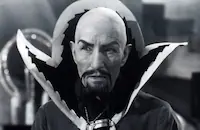Welcome Danger

Brief Synopsis
Cast & Crew
Clyde Bruckman
Harold Lloyd
Barbara Kent
Noah Young
Charles Middleton
William Walling
Film Details
Technical Specs

Synopsis
Harold Bledsoe, the son of a former chief of police in San Francisco, is called to the city to quell the flourishing crime among Asian and American gangsters. En route, Harold, a meek botanist, stops to examine some flowers and misses his train, but he gets a ride with Billy Lee and her young crippled brother, who are going to San Francisco for an operation on the boy's leg. Dr. Gow, a kindly physician, complains of the evil of narcotics to Captain Walton, as does John Thorne, a supposed reformer but actually an underworld leader. Harold promises action, and, disguised as a Chinese man, he infiltrates a flower shop to rescue the doctor from the villains. The criminals escape, but by matching a set of fingerprints, Harold proves Thorne's guilt and forces a confession from him.

Director
Clyde Bruckman
Cast

Harold Lloyd

Barbara Kent
Noah Young

Charles Middleton
William Walling
James Wang
Douglas Haig
Crew

Photo Collections
Videos
Movie Clip



Film Details
Technical Specs

Articles
Welcome Danger
But it wasn't smooth sailing. The first cut of Welcome Danger ran sixteen reels (about 2 hours and 45 minutes). And though, according to Lloyd, test audiences enjoyed Welcome Danger at its original length, it was far too long to be commercially successful in that day of standard 90 minute features. Reducing the film by three to four reels seemed to make it worse, according to preview audiences. It took cutting out almost ten reels before Lloyd and audiences both agreed that the movie "started to perk up again." However, on the final night of previews after Lloyd was satisfied with his cut of Welcome Danger, he saw another sound comedy that would make him change his mind.
Lloyd was astonished at the comedy audience's reaction simply to sound...nothing more. It wasn't even necessarily the jokes that brought down the house. As Lloyd recalled, "they had the punkest gags in it, but they were laughing at the pouring of water, the frying of eggs...it didn't matter...the clinking of ice in a glass. We worked our hearts out to get laughs with thought-out gags, and look here: just because they've got some sound in it, they're roaring at these things." It must have been a difficult night for Lloyd, seeing clearly for the first time that his art form had been rendered pass¿He became convinced that Welcome Danger would fail if it was released as a silent and finally told his crew, "we've got to convert this into a sound picture, some way."
The first step was to hire a new director. Malcolm St. Clair had competently directed the silent version of Welcome Danger. But Lloyd knew he'd need an ace to pull off this feat - making a silent picture talk. And so, he brought in legendary writer/director Clyde Bruckman, who first got his feet wet in Hollywood writing Buster Keaton comedies like Sherlock, Jr. (1924) and Seven Chances (1925). Lloyd and Bruckman met up in 1925 when Bruckman helped pen Lloyd's hit The Freshman. Ever the chameleon, Bruckman also directed several Laurel and Hardy silents such as Putting Pants on Philip and Battle of the Century (both 1927) and co-directed Keaton's The General (1927).
Bruckman's solution for Welcome Danger was to scrap half and dub the rest. It was a process that Lloyd remembered as a nightmare in retrospect. "The dubbing was horrible," he recalled. "We didn't know what we were doing." But apparently they did something right. The movie was a hit. At a total cost of $980,000 ($290,000 of which comprised the cost of the "second" film - the addition of sound), Welcome Danger took in nearly three million dollars and became Lloyd's biggest hit since The Freshman. It seems Lloyd was correct and plot mattered little. Audiences flocked simply to hear their silent stars talk.
Certainly, looking back Welcome Danger isn't one of Lloyd's funniest efforts, but it was an interesting experiment. And as Lloyd himself would remark some thirty years later, he believed the movie pulled together "the pace and quality of a silent picture...in a sound film."
Producer: Harold Lloyd
Director: Clyde Bruckman, Malcolm St. Clair
Screenplay: Clyde Bruckman, Felix Adler, Lex Neal
Art Direction: Liell K. Vedder
Cinematography: Henry Kohler, Walter Lundin
Editing: Bernard W. Burton, Carl Himm
Music: Constantin Bakaleinikoff
Cast: Harold Lloyd (Harold Bledsoe), Barbara Kent (Billie Lee), Noah Young (Officer Patrick Clancy), Charles Middleton (John Thorne/The Dragon), William Walling (Captain Walton).
BW-115m.
by Stephanie Thames

Welcome Danger
Quotes
Trivia
Originally filmed as a silent feature (directed by Malcolm St. Clair) it was largely re-shot for sound release (directed by Clyde Bruckman.) When it was previewed, it was over three hours in length, but cut to under two hours before general release.
Notes
Copyrighted as 12 reels. Also si; 10,796 ft.














